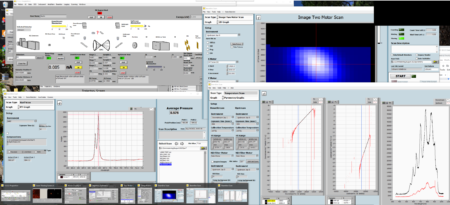 At this year’s ALS User Meeting, Kevan Anderson, on behalf of the Beamline Controls Group (BCG), was honored with the 2022 Tim Renner User Services Award. The ALS Users’ Executive Committee made the selection for “broad expertise in control systems and software development, and professional judgment and decision-making, which have greatly contributed to the research and development program of the Advanced Light Source.”
At this year’s ALS User Meeting, Kevan Anderson, on behalf of the Beamline Controls Group (BCG), was honored with the 2022 Tim Renner User Services Award. The ALS Users’ Executive Committee made the selection for “broad expertise in control systems and software development, and professional judgment and decision-making, which have greatly contributed to the research and development program of the Advanced Light Source.”
Although the Renner Award is given to an individual, Anderson views the accomplishment as a group effort. “It has been really amazing working with the beamline controls team, both the team that was here before I joined ALS and the team that we’ve hired after that,” he said, referring to the complete group which includes Earl Cornell, Jeff Dickert, Damon English, Martin Keller, Yunian Lou, and Lee Yang. He praised his colleagues for being truly collaborative and trying to provide the best software to the beamlines, which is a different atmosphere than other places he has worked with in the past. “They are constantly just exceeding my expectations when it comes to the things that they’re able to do to help out the beamline scientists and the users as they’re here at the ALS.”
All things that can be changed along a beamline (anywhere from the first mirror through the endstation) are the responsibility of the BCG. This includes the motors, the different detectors, and the endstation, all of which need to be integrated into a system that allows users and beamline scientists to change settings and collect their data. “You build the layer that talks to the hardware. Then you build the layer that collects that data, or can look at the data that’s coming in from that beamline,” Anderson explained.
Martin Kunz, ALS senior scientist at Beamline 12.2.2, described how much his beamline relies on the BCG for developing new experiments and improving old interfaces. “The complexity of our system also makes it susceptible to all kinds of unforeseen hiccups that sometimes require immediate attention,” he said. Even outside business hours, “the Controls Group excels at almost instantaneous responses to deployed SOS signals,” he added, crediting the group’s work for preserving user beamtime.
ALS Scientist Alexei Federov explained how the work of the BCG is woven into the user experience. ”All users coming to the ALS cannot miss seeing results of the work performed by this group of very competent and highly skilled software developers as it is literally on display on the screens of every computer serving the beamline or an instrument attached to it,” he noted. However, the seamless experience may not allow users to understand how the software came to be. “The users accustomed to interacting with all sorts of apps probably do not even recognize the amount of work, dedication, mastery and sheer time behind those familiar windows,” he said—windows where users can change wavelength, bandpass, temperature, position, and more.

Many users bring their own equipment to the ALS, and the BCG helps integrate the components into the facility’s system. “We can do a ton of stuff with one month’s notice,” Anderson said, including working with users to coordinate all the software. “If they remember how things worked the last time they were here, that’s also helpful,” he added. Over time, these relationships and collaborations have produced untold scientific achievements.
Senior Scientist Valeriy Yashchuk also applauded the group for their collaborative work. “They have an outstanding ability for effective and productive communication with people of our diverse and multicultural community of scientists, engineers, and technicians,” he said. Through their broad knowledge in control systems and software development for physical experiments, “they significantly contribute to the research and development program of the Advanced Light Source.”
As the group leader, Anderson witnesses the individual contributions that come together to support all the projects at the ALS. “Every one of them has this different goal, this unique thing that they’re trying to do, that’s a little bit different than what anybody else is doing. And we get to learn just enough to capture that in the software so that they can get the data that they need.”
Tim Renner was a beamline scientist at the ALS whose battle with cancer cut short a career distinguished by a caring attitude and larger-than-life personality. This award recognizes the services of people across the ALS organization who have made outstanding contributions to the ALS user community.